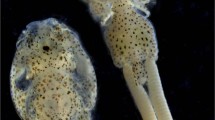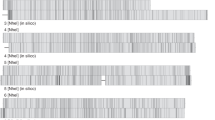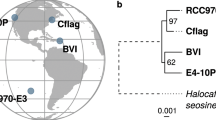Abstract
Vibrio qinghaiensis sp.-Q67 (Vqin-Q67) is a freshwater luminescent bacterium that continuously emits blue-green light (485 nm). The bacterium has been widely used for detecting toxic contaminants. Here, we report the complete genome sequence of Vqin-Q67, obtained using third-generation PacBio sequencing technology. Continuous long reads were attained from three PacBio sequencing runs and reads >500 bp with a quality value of >0.75 were merged together into a single dataset. This resultant highly-contiguous de novo assembly has no genome gaps, and comprises two chromosomes with substantial genetic information, including protein-coding genes, non-coding RNA, transposon and gene islands. Our dataset can be useful as a comparative genome for evolution and speciation studies, as well as for the analysis of protein-coding gene families, the pathogenicity of different Vibrio species in fish, the evolution of non-coding RNA and transposon, and the regulation of gene expression in relation to the bioluminescence of Vqin-Q67.
Design Type(s) | sequence assembly objective |
Measurement Type(s) | genome assembly |
Technology Type(s) | DNA sequencing |
Factor Type(s) | |
Sample Characteristic(s) | Vibrio sp. Q67 |
Machine-accessible metadata file describing the reported data (ISA-Tab format)
Similar content being viewed by others
Background & Summary
Luminous bacteria are a group of bacteria that have the ability to produce light, and are very common in ocean environments. However, some species of luminous bacteria have been found in terrestrial environments. Vibrio qinghaiensis sp.-Q67 (Vqin-Q67) is a luminous bacterium that was first isolated from Qinghai Lake, Qinghai Province, China1. It has proved to be very sensitive in detecting environmental and food pollutants such as phthalate esters2 and fusaric acid3. The light-emitting mechanism of luminous bacteria is associated with the presence of lux genes coding luciferases, which catalyse the oxidation of a reduced flavin mononucleotide (FMNH2) and a long-chain aliphatic (fatty) aldehyde (RCHO) to generate blue-green light in the presence of O2 (ref. 4). A previous study showed that the luminescence of V. fischeri relies on activation of a transcriptional protein, LuxR, which is associated with N-3-oxo-hexanoyl-HSL (3OC6-HSL) and/or N-octanoyl-HSL (C8-HSL) to form a complex binding at the promoter site within the lux operon to activate transcriptional regulation of these light production-associated genes5. V. fischeri has been isolated from ocean environments6, while Vqin-Q67 has been identified as the only known luminous bacterium belonging to the family Vibrionaceae found in a fresh water enivronment. To date, very little information is know about the genome, or the genes involved in the luminescence, of Vqin-Q67.
In the present study, Vqin-Q67 was cultured in modified Czapek’s broth medium containingNaHCO3 (1.345 g l−1), K2HPO4 (0.0136 g l−1), Na2HPO4 (0.0358 g l−1), MgCl2·6H2O (0.60 g l−1), CaCL2 (0.033 g l−1), MgSO4·7H2O (0.246 g l−1), NaCl (1.54 g l−1), yeast extract (5.0 g l−1), tryptone (5.0 g l−1) and glycerinum (3.0 g l−1)at 22 °C with shaking (120 rpm) for 48 h. When blue-green light became visible (Fig. 1), the bacterial cells were collected by centrifugation at 4,000×g for 10 min and then immediately stored in liquid nitrogen for further experimental analysis. The genome of Vqin-Q67 was sequenced as the flowchart shown in Fig. 1. The PacBio RS II system with P4/C2 chemistry (Pacific Biosciences, Menlo Park, CA, USA) recently has been developed a single-molecule real-time (SMRT) analysis7. The advantages of PacBio sequencing are the resulting highly-contiguous de novo assembly and longer read length (>10 Kb), which can close the gaps in assembled genome sequence and allow read-through of repetitive regions and. The aim of this study is to obtain a complete genome sequence for Vqin-Q67. This dataset reported here will be useful for analysis of protein-coding gene families, for comparative genomic analysis of evolution and pathogenicity among different Vibrio species, for analysis of non-coding RNA and transposon evolution at a whole genome level, and for analysis of the regulation of gene expression in relation to the bioluminescence of Vqin-Q67.
Methods
Genomic DNA preparation
Genomic DNA was extracted using E.Z.N.A. Fungal DNA Kit (Omega Bio-tek, Hangzhou, China) according to the manufacturer’s instructions. The DNA quality was evaluated using a Qubit fluorometer (Thermo Fisher Scientific, Waltham, MA) and Nanodrop spectrophotometer (Thermo Fisher Scientific).
Sequencing
Qualified genomic DNA was fragmented using G-tubes (Covaris) and then end-repaired to prepare SMRTbell DNA template libraries (with a fragment size >10 kb selected using a bluepippin system) according to the manufacturer’s instructions (Pacific Biosciences). Library quality was analysed by Qubit, and average fragment size was estimated using a Agilent 2,100 Bioanalyzer (Agilent, Santa Clara, CA, USA). SMRT sequencing was performed using a Pacific Biosciences RSII sequencer (PacBio, Menlo Park, CA) and standard protocols (MagBead Standard Seq v2 loading, 1×180 min movie) using P4-C2 chemistry.
De novo genome assembly
Continuous long reads of >500 bp, with a quality value of >0.75, obtained from three SMRT sequencing runs were first merged into a single dataset. Next, the random errors in the long seed reads (seed length threshold 6 kb) were corrected by aligning the long reads against shorter reads from the same library using the hierarchical genome-assembly process (HGAP) pipeline8. The resulting corrected, preassembled reads were used for de novo assembly using Celera Assembler with an overlap-layout-consensus strategy9. Due to SMRT sequencing with very little variations in the quality throughout the reads10, hence no quality values were utilized during the assembly. the Quiver consensus algorithm8 was used to validate the quality of the assembly and to determine the final genome sequence. Finally, the ends of the assembled sequence were trimmed to circularize the genome. The completeness of the genomics data was assessed by BUSCO11.
Gene prediction
The open reading frames (ORFs) were predicted using GeneMarkS12, which is a well-studied gene finding program used for prokaryotic genome annotation. Repetitive elements were identified by RepeatMasker13. Noncoding RNAs were predicted using rRNAmmer14 and tRNAs were identified using tRNAscan15.
Genome annotations
Several complementary approaches were used to annotate the assembled sequences. The genes were annotated by aligning the sequence with sequences previously deposited in diverse protein databases including the National Center for Biotechnology Information (NCBI) non-redundant protein (Nr) database, UniProt/Swiss-Prot, Kyoto Encyclopedia of Genes and Genomes (KEGG), Gene Ontology (GO), Cluster of Orthologous Groups of proteins (COG), and protein families (Pfam). Additional annotation was carried out using the following databases: Pathogen Host Interactions (PHI), Virulence Factors of Pathogenic Bacteria (VFDB), Antibiotic Resistance Genes Database (ARDB), Carbohydrate-Active enZYmes (CAZy). Prophages were identified using the PHAge Search Tool (http://phast.wishartlab.com). Nr and GO annotation was carried out using Blast2GO, while protein families (Pfam) annotation was applied using Pfam_Scan (https://www.ebi.ac.uk/Tools/pfa/pfamscan/). An E-value of 1e−5 was used as the cut-off for all basic local alignment search tool.
Code availability
Most of the custom codes used for dataset analysis were stated in the methods section, with default parameters used in other cases. Other softwares used in this study are as follows. The hierarchical genome-assembly process was performed using HGAP (smrtanalysis-2.3.0). The ORFs were predicted using Glimmer v3.02, and repetitive elements were identified by RepeatMasker (version open-4.0.5). Noncoding RNAs, such as rRNAs, were predicted using rRNAmmer (rnammer-1.2) and tRNAs were identified by tNRAscan (SE-1.3.1). More detailed information is provided in Table 1.
Data Records
All of the raw reads for the Vqin-Q67 genome have been deposited in the NCBI Sequence Read Archive under accession number SRP108403 (Data Citation 1). All predicted genes and their functional annotations for the Vqin-Q67_ chromosome_1 and chromosome_2, have been depositied into GenBank under accession number GCA_002257545.1 (Data Citation 2).
Technical Validation
The presence of low quality or contaminated reads amongst the raw reads decrease the technical quality of the de novo assembly. To ensure the quality of the final assembly, raw reads and subreads were filtered to obtain clean reads for further assembly. Most of the short reads <100 bp were identified as adapter dimers (0–10 bp) or short fragment contamination (11–100 bp), filtering retained only raw reads with a length >100 bp, and an estimated accuracy of at least 80%. Although, this process may remove some true reads and reduce the number of reads from the raw pools, it resulted in a high-quality assembly with an average read length of 9,600 bp (Fig. 2b) and an accuracy of 0.859 (Fig. 2d). In the sub-read filtering step, we removed the adapter from the raw reads to obtain clean sub-reads with a mean length of 6,655 bp and a N50 of 8,487 bp (Supplementary Table 1). Results showed that the final assembly and annotation of Vqin-Q67 genome was 99.6% complete (Fig. 3), suggesting that most of the recovered genes could be classified as ‘complete and single-copy’.
The de novo assembled genome is 4 Mb in size and is comprised of two chromosomes (chr_1 and chr_2) with an average GC content of 44.86 and 43.51%, respectively (Fig. 4). The two chromosomes were predicted to contain 2,591 and 1,372 protein-coding genes, respectively. All of the genes could be functionally annotated. The lux genes, which appear to be physically linked on chr_2, were identified as gene numbers 1,177 (luxC), 1,178 (luxD), 1,179 (luxA), 1,180 (luxB), 1,181 (luxE) and 1,182 (luxG). The LuxCDABEG arranement is typical of previously reported lux operons, including those in Vibrio campbellii16, Vibrio cholerae17 and Photobacterium leiognathi18. In addition, luxR (gene no. 1,329) also existed in the downstream of the luxCDABEG operon, which is consistent with other Vibrio species5. Based on 16S RNA gene sequence alignments (data not shown), Vqin-Q67 was found to be closely related to Vibrio anguillarum 775. V. anguillarum 775 is a highly virulent strain causing vibriosis in fish19. In contrast, Vqin-Q67, isolated from Gymnocypris przewalskii in Qinghai Lake, has a symbiotic relationship with its host1. Comparative genomic analysis and functional annotation supported the different natures of Vqin-Q67 and V. anguillarum 775. Synteny analysis showed frequent gene rearrangements between Vqin-Q67 and V. anguillarum 775, suggesting similarity regions of 82.09 and 77.53%, respectively (Fig. 5). This may account for their differences in pathogenicity to fish. Pathogen-host interaction proteins (PHIP) play an important role in modulating the host immune system20. However, whole-genome analysis of Vqin-Q67 in the current study showed that all proteins annotated as PHIP had only low identity (average 31%), which supports Vqin-Q67 being a symbiotic bacterium.
Nucleotide positions in the two genomes are indicated by 0, 1, 2, 3, and 4 M and the similarity regions are indicated by dark blue colour. Regions having undergone rearrangements are shown in gray. Red ribbons joining the two arcs indicate the synteny in the forward orientation, while the green ribbons indicate in the reverse orientation.
In summary, this dataset was optimized using the above parameters and quality control measures, and therefore, should be free from errors. Furthermore, the comparative genomic and annotation analyses performed using this dataset provides powerful evidence for its high level of accuracy and practicability.
Additional information
How to cite this article: Gong, L. et al. Complete genome sequencing of the luminescent bacterium, Vibrio qinghaiensis sp. Q67 using PacBio technology. Sci. Data 5:170205 doi:10.1038/sdata.2017.205 (2018).
Publisher’s note: Springer Nature remains neutral with regard to jurisdictional claims in published maps and institutional affiliations.
References
References
Zhu, W. J. et al. Y. A new species of luminous bacteria Vibrio qinghaiensis sp. nov. Oceanologia et Limnologia Sinica 25, 273–279 (1994).
Ding, K. K. et al. In vitro and in silico investigations of the binary-mixture toxicity of phthalate esters and cadmium (II) to Vibrio qinghaiensis sp.-Q67. Sci. Total Environ. 580, 1078–1084 (2017).
Li, J. et al. A luminescent bacterium assay of fusaric acid produced by Fusarium proliferatum from banana. Anal. Bioanal. Chem. 402, 1347–1354 (2012).
Urbanczyk, H., Ast, J. C. & Dunlap, P. V. Phylogeny, genomics, and symbiosis of Photobacterium. FEMS Microbiol. Rev. 35, 324–342 (2011).
Colton, D. M., Stabb, E. V. & Hagen, S. J. Modeling analysis of signal sensitivity and specificity by Vibrio fischeri LuxR variants. PLoS One 10, e0126474 (2015).
Ruby, E. G. & Morin, J. G. Specificity of symbiosis between deep-sea fish and psychrotrophic luminous bacteria. Deep-Sea Res. 25, 161–171 (1978).
Eid, J. et al. Real-time DNA sequencing from single polymerase molecules. Science 323, 133–138 (2009).
Chin, C. S. et al. Nonhybrid, finished microbial genome assemblies from long-read SMRT sequencing data. Nat. Methods 10, 563–569 (2013).
Myers, E. W. et al. A whole-genome assembly of Drosophila. Science 287, 2196–2204 (2000).
Koren, S. et al. Hybrid error correction and de novo assembly of single-molecule sequencing reads. Nat. Biotechnol. 30, 693–700 (2012).
Simão, F. A. et al. BUSCO: assessing genome assembly and annotation completeness with single-copy orthologs. Bioinformatics 31, 3210–3212 (2015).
Besemer, J., Lomsadze, A. & Borodovsky, M. GeneMarkS: a self-training method for prediction of gene starts in microbial genomes. Implications for finding sequence motifs in regulatory regions. Nucleic Acids Res. 29, 2607–2618 (2001).
Tarailo-Graovac, M. & Chen, N. Using RepeatMasker to identify repetitive elements in genomic sequences. Curr. Protoc. Bioinformatics 4, 10 (2009).
Lagesen, K. et al. RNAmmer: consistent and rapid annotation of ribosomal RNA genes. Nucleic Acids Res. 35, 3100–3108 (2007).
Lowe, T. M. & Sean, R. E. tRNAscan-SE: a program for improved detection of transfer RNA genes in genomic sequence. Nucleic Acids Res. 25, 955–964 (1997).
Lin, B. et al. Comparative genomic analyses identify the Vibrio harveyi genome sequenced strains BAA-1116 and HY01 as Vibrio campbellii. Environ. Microbiol. Rep. 2, 81–89 (2010).
Ramaiah, N. et al. Detection of luciferase gene sequences in non-luminescent bacteria from the Chesapeake Bay. FEMS Microbiol. Ecol. 33, 27–34 (2000).
Lee, C. Y., Szittner, R. B. & Meighen, E. A. The lux genes of the luminous bacterial symbiont, Photobacterium leiognathi, of the ponyfish. Nucleotide sequence, difference in gene organization, and high expression in mutant Escherichia coli. Eur. J. Biochem. 201, 161–167 (1991).
Naka, H. et al. Complete genome sequence of the marine fish pathogen Vibrio anguillarum harboring the pJM1 virulence plasmid and genomic comparison with other virulent strains of V. anguillarum and V. ordalii. Infect. Immun. 79, 2889–2900 (2011).
Durmuş Tekir, S. D. & Ülgen, K. Ö. Systems biology of pathogen-host interaction: networks of protein-protein interaction within pathogens and pathogen-human interactions in the post-genomic era. Biotechnol. J. 8, 85–96 (2013).
Data Citations
NCBI Sequence Read Archive SRP108403 (2017)
NCBI Assembly GCF_002257545.1 (2017)
Acknowledgements
This research was supported by the National Natural Science Foundation of China (No. 31401593 and 31772033), Pearl River Nova Program of Guangzhou (No. 201710010135), the Science and Technology Planning Project of Guangdong Province (No. 2015B090901058), the Science and Technology Planning Project of Guangzhou (No. 201604020048), Talent Program of Guangdong Province (No. 2014TX01N049).
Author information
Authors and Affiliations
Contributions
L.G. designed the experiments, analysed the data and wrote the manuscript. W.Y. and J.Q.J. contributed to materials and sequencing. Y.C.X. performed the experiments and analysed the data. V.K.G. contributed to materials, analysed the data and prepared the manuscript. X.W.D. designed the experiments, contributed to sequencing and wrote the manuscript. J.Y.M. conceived and designed the experiments.
Corresponding author
Ethics declarations
Competing interests
The authors declare no competing financial interests.
ISA-Tab metadata
Supplementary information
Rights and permissions
Open Access This article is licensed under a Creative Commons Attribution 4.0 International License, which permits use, sharing, adaptation, distribution and reproduction in any medium or format, as long as you give appropriate credit to the original author(s) and the source, provide a link to the Creative Commons license, and indicate if changes were made. The images or other third party material in this article are included in the article’s Creative Commons license, unless indicated otherwise in a credit line to the material. If material is not included in the article’s Creative Commons license and your intended use is not permitted by statutory regulation or exceeds the permitted use, you will need to obtain permission directly from the copyright holder. To view a copy of this license, visit http://creativecommons.org/licenses/by/4.0/ The Creative Commons Public Domain Dedication waiver http://creativecommons.org/publicdomain/zero/1.0/ applies to the metadata files made available in this article.
About this article
Cite this article
Gong, L., Wu, Y., Jian, Q. et al. Complete genome sequencing of the luminescent bacterium, Vibrio qinghaiensis sp. Q67 using PacBio technology. Sci Data 5, 170205 (2018). https://doi.org/10.1038/sdata.2017.205
Received:
Accepted:
Published:
DOI: https://doi.org/10.1038/sdata.2017.205
This article is cited by
-
Cellular differentiation into hyphae and spores in halophilic archaea
Nature Communications (2023)
-
Construction of luminescent Escherichia coli via expressing lux operons and their application on toxicity test
Applied Microbiology and Biotechnology (2022)
-
Genome sequence and transcriptomic profiles of a marine bacterium, Pseudoalteromonas agarivorans Hao 2018
Scientific Data (2019)
-
Complete genome sequencing of Comamonas kerstersii 8943, a causative agent for peritonitis
Scientific Data (2018)
-
Comparative shotgun metagenomic data of the silkworm Bombyx mori gut microbiome
Scientific Data (2018)








